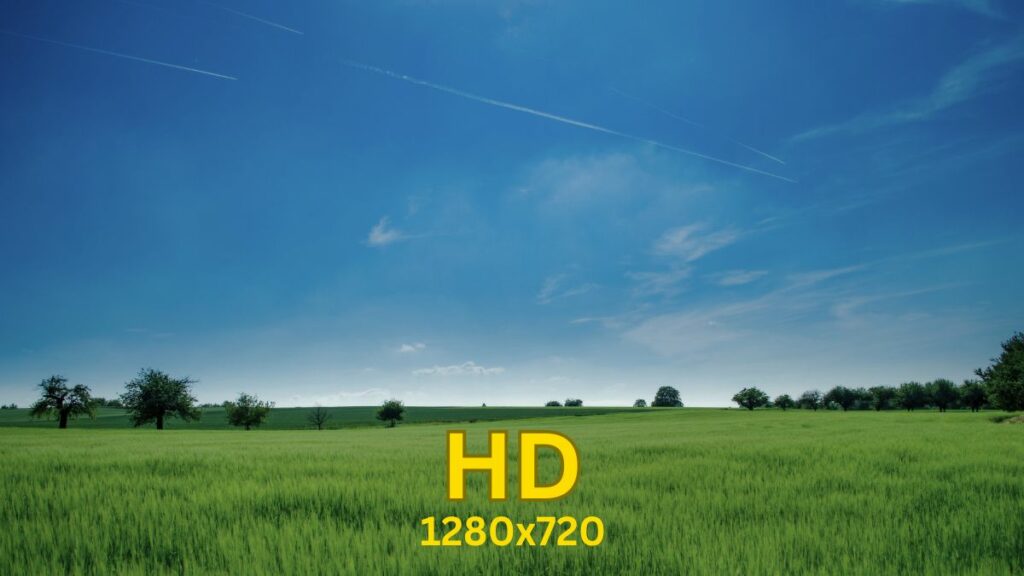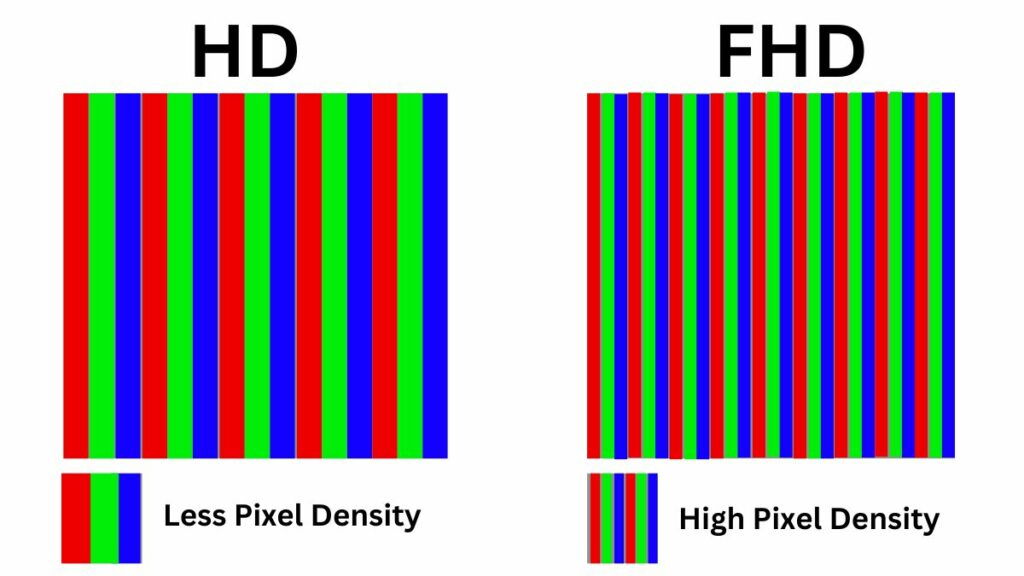HD (High Definition) and FHD (Full High Definition) are popular in screens and displays.
These acronyms represent how clear and detailed images and videos can be on your device.
But how do you decide which one is right for you?
HD, also known as 720p, has a resolution of 1280×720 pixels. It is older and has a less clear screen. FHD, which has a resolution of 1920×1080 pixels, is clearer and more detailed. The choice between these two depends on how big your screen is.
In this article, We’ll look at
- The difference between HD and FHD
- What devices they’re best for? and
- How do they affect gaming?
By the end, you’ll know which resolution suits your needs.
HD vs. FHD: Differences
HD means High Definition, and its resolution is 1280×720 pixels. Also called “720p” or “HD ready,” its resolution consists of 1280 horizontal and 720 vertical pixels.
Although not as good as Full HD, it is still significantly better than SD, making it suitable for many displays and devices.
Full HD means complete high definition, and its resolution is 1920×1080 pixels. This resolution consists of 1920 horizontal and 1080 vertical pixels. Full HD is the standard resolution for high-definition displays and content. FHD offers a higher level of detail and clarity than HD.


HD vs FHD: Full Comparison [Specifications]
Resolution and Visual Quality
| Feature | HD (High Definition) | FHD (Full High Definition) |
|---|---|---|
| Resolution | 1280×720 pixels (Good, but not as sharp or detailed as FHD) | 1920 x 1080 pixels(Sharper and more detailed) |
| Pixel Density | 294 PPI (approximately) | 441 PPI (approximately) |
| Aspect Ratio | 16:9 | 16:9 |
| Clarity | HD displays provide a lower level of clarity and detail compared to FHD | FHD displays provide a significantly higher level of clarity and detail compared to HD |
| Display | FHD displays offer excellent clarity and sharpness, making them suitable for larger screens like televisions, computer monitors, and projectors. | FHD displays offer excellent clarity and sharpness, making them suitable for larger screens like televisions, larger computer monitors, and projectors. |
Suitability
| Feature | HD (High Definition) | FHD (Full High Definition) |
|---|---|---|
| Screen Size | Perfect for smaller display HD TVs: 19 to 55 inches HD Computer Monitors: 15 to 34 inches HD Smartphones and Tablets: 4 to 7 inches | Perfect for bigger display FHD TVs: 32 to 85 inches FHD Computer Monitors: 21 to 34 inches FHD Smartphones and Tablets: 5 to 7 inches |
| Battery | Reduced Battery Usage | Increase Battery Usage |
| Compatibility | HD displays are often found in various devices, such as HD TVs, HD computer monitors, HD projectors, and HD smartphones | FHD screens are commonly used in modern devices, including FHD TVs, FHD computer monitors, FHD laptops, and FHD smartphones. |
| Hardware | HD displays are less hardware-intensive and are common in various devices | FHD devices need powerful hardware, impacting battery life and performance |
| Suitable applications | Productivity tasks, office usage, secondary monitors. | Gaming, entertainment, content creation. |
Cost
| Feature | HD (High Definition) | FHD (Full High Definition) |
|---|---|---|
| Cost | Lower Cost due to standard tech | Higher Cost due to advanced tech |


HD vs FHD: Detail Comparison
Screen Resolution
The standard resolution of HD is 1280 x 720 pixels. It has 1280 rows and 720 columns. Due to 720 columns, it is also called 720p. HD screens produce greater detail and resolution, especially on smaller devices.
At the same time, the standard resolution of an FHD display is 1920 × 1080 pixels (1080p), that is, 1920 x 1080 pixels horizontally and vertically.
Full HD displays offer excellent detail rendition and clarity, perfect for larger displays that produce even better detail and resolution.
Also Read: What is Pixel? Everything You Need to Know

Display Size
HD displays are commonly found in a variety of screen sizes. It is best for smartphone screens ranging from 4 to 6 inches but is also found in larger-sized smartphones. This is great for smaller computer monitor screens starting from 19 inches up to about 24 inches. Apart from this, some entry-level HDTVs start from 24 inches and are available in larger sizes.
FHD displays are also commonly used in various screen sizes, most commonly found in high-end smartphones, ranging from 5 to 6.5 inches. Additionally, it is perfect for computer monitors ranging from 21-inches to ultrawide 34-inches. It is also suitable for modern HDTVs from 32 inches to larger sizes, and laptops are better for 13 to 17 inches.
Battery Life
Devices with FHD screens consume slightly more power than devices with HD screens due to their higher resolution. Generally, FHD has higher resolution, and photos and videos look more apparent, so FHD requires more CPU power; Therefore, FHD consumes more battery.
Compatibility
HD and FHD are generally compatible, and their compatibility mainly revolves around the device being used and the content it plays. HD content can be displayed on both HD and FHD screens, while FHD content is optimized for FHD screens and can be easily viewed on HD screens even with downscaling.
HD displays are often found in HD TVs, computer monitors, projectors, and smartphones.
FHD screens are commonly found in FHD TVs, computer monitors, laptops, and smartphones.
Color Accuracy
HD displays, in particular, offer superior color accuracy if well-calibrated. Due to their high pixel density, HD resolution colors look good on small-screen computer screens and mobile phones.
FHD displays, like HD displays, offer good color accuracy when nicely calibrated. FHD screens provide more accurate and detailed colors than HD screens. FHD displays, especially on smartphones, laptops, and computer monitors, often deliver excellent color accuracy and vibrancy.
Refresh Rate
HD displays come with different refresh rates, including 60Hz and 120Hz. 60Hz is the most common refresh rate for HD screens. For smoother gameplay, some HD displays have higher refresh rates, 120Hz or 144Hz.
FHD displays typically come with refresh rates of 60Hz, 120Hz, 144Hz, and even higher, depending on the device and its intended use. The FHD display with 60Hz refresh rates is suitable for standard computing tasks and media consumption. But FHD displays with higher refresh rates, 120Hz and 144Hz, are considered best for gaming and more demanding tasks.
GPU and CPU Requirement
High-definition displays (720p) have relatively low GPU requirements. Even with the integrated GPU, it handles daily tasks, web browsing, and video playback at HD resolution. Mid-range and budget CPUs can easily handle HD resolution for standard tasks.
FHD monitors (1080p) require more GPU processing power, especially when playing games or performing heavy graphics tasks. For games with FHD resolution with high-quality settings, a high-end dedicated GPU is required for smooth performance. The integrated GPU has difficulty handling Full HD gaming at high settings.
Also Read: What to Look for in a Graphics Card?
Pricing
FHD (Full High Definition) displays are generally more expensive than HD (High Definition) displays. This price difference varies depending on the device’s size, brand, and specifications.
However, it’s essential to consider other factors like screen size, panel type, and features when evaluating the cost difference between HD and FHD options for your specific needs.
Is FHD better than HD?
FHD is better than HD. FHD stands for Full High Definition, and its resolution is 1920×1080 pixels. HD, or high definition, has a resolution of 1280×720 pixels. It means that FHD has twice as many pixels as HD, resulting in a clearer and more detailed image in FHD.
HD vs. FHD: Which one is Best?
For Gaming Laptops
When choosing between HD and FHD for a gaming laptop, FHD is generally considered the better choice. Laptops with FHD displays are better because of higher resolution, better visual quality, wider game compatibility, and versatility for other tasks.
However, gaming laptops require a capable GPU to handle FHD gaming effectively. Also, gaming laptops with FHD displays have concise battery life.
Also Read: Best PC Games to Play
For Mobile Phone
Both HD and FHD are suitable for mobile phones. But you must consider your specific needs and preferences when choosing between them.
If you prioritize visual quality, enjoy content consumption and gaming, and have a large smartphone screen, then FHD is good for you. If you’re on a budget, you might value slightly lower visual quality and longer battery life. So an HD screen would be better for you as it still presents a good experience on a smaller screen.
For Monitor
When choosing between HD and FHD monitors, the decision primarily depends on your specific use case, preferences, and budget. FHD monitors are generally popular due to their superior visual quality, gaming capabilities, productivity benefits, and multimedia performance. But it must be remembered that an FHD monitor requires more CPU power and electricity and is also more expensive.
If you are on a tight budget or need a monitor for basic tasks where resolution doesn’t matter, an HD monitor that still performs well may also be enough for you.
Final Word
Regarding screen resolution, FHD is far from HD, offering a clearer picture with its 1920×1080 pixels compared to HD’s 1280×720 pixels. Additionally, for gaming laptops and monitors, FHD is better, making games look and play better.
FHD also works well on mobile phones for watching videos and playing games, but HD is still good if you are on a budget. Your choice depends on what you need and how much you can spend. FHD costs a little more, but it’s often worth it for the better quality.
FAQs
For mobile phones, FHD displays are better than HD displays because watching videos and playing games on FHD screens is more fun than HD.
Yes, you can play HD content on FHD screens because the resolution of FHD is higher than HD’s.
FHD has become the standard resolution for many modern devices, including smartphones, laptops, monitors, and TVs, due to its superior visual quality and compatibility with HD content.
Due to the higher resolution, FHD screens consume more power than HD screens, which leads to shorter battery life on devices with FHD screens.
FHD is better for watching movies because it provides a clearer and more immersive viewing experience with sharper images and vibrant colors.




